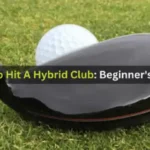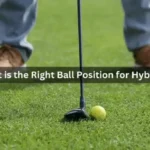The slice is a common golf shot that many players struggle with, resulting in errant ball flight and frustration on the course. Mastering the art of correcting a slice can unlock your full golfing potential and lead to more consistent, enjoyable rounds. In this article, we’ll delve into the causes of a slice and explore proven techniques to straighten out your swing.
Understanding the Slice
A slice occurs when the golf ball curves significantly to the right (for right-handed golfers) upon leaving the club face. This unwanted ball flight is often caused by an open club face at impact, combined with an outside-to-in swing path. The result is a ball that starts left of the target and then slices dramatically to the right.
Identifying the Causes of a Slice
Several factors can contribute to the development of a slice in your golf swing. Common culprits include:
- Weak Grip: A grip that is too weak, with the hands rotated too far to the right, can lead to an open club face at impact.
- Over-the-Top Swing: An over-the-top swing path, where the club comes down from the outside, creates an outside-to-in swing path and an open club face.
- Lack of Shoulder Rotation: Insufficient shoulder rotation during the backswing can prevent the club from reaching the proper position at the top of the swing, leading to an open club face.
- Excessive Slice Spin: A slice is caused by an open club face, which imparts unwanted side spin on the ball. This excess spin can exacerbate the slice’s curvature.
Techniques to Correct a Slice

Now that we’ve identified the primary causes of a slice, let’s explore proven techniques to help you straighten out your swing:
Adjust Your Grip
Start by examining your grip. If it’s too weak, try strengthening it by rotating your hands slightly to the left. This will help close the club face at impact and reduce the likelihood of a slice.
Improve Your Swing Path
Work on developing an inside-to-out swing path. One effective drill is to set up alignment sticks or other visual aids to guide your swing and encourage an in-to-out swing path.
Increase Shoulder Rotation
Enhance your shoulder rotation during the backswing by focusing on turning your chest and shoulders more fully. This will help you achieve a better position at the top of the swing, leading to a more controlled downswing.
Reduce Slice Spin
To minimize slice spin, consider using a lower-spinning golf ball or experiment with different club head designs that are less prone to imparting excessive side spin.
Maintain Consistent Ball Position
Ensure that your ball position remains consistent throughout your swing. Placing the ball too far forward in your stance can contribute to an open club face and a slice.
Seek Professional Guidance
If you’ve tried these techniques and are still struggling with a persistent slice, consider seeking the guidance of a qualified golf instructor. They can provide personalized feedback and help you identify and address the specific issues in your swing.
Remember, correcting a slice takes time, patience, and consistent practice. By addressing the underlying causes and implementing these strategies, you’ll be well on your way to achieving a more controlled, penetrating ball flight and lower scores on the golf course.
FAQS
Q: What is a slice in golf?
A: A slice is a type of golf shot where the ball curves dramatically to the right for right-handed players, or to the left for left-handed players. It is often caused by an outside-to-inside swing path and an open clubface at impact.
Q: Why do I slice my driver but not my irons?
A: Slicing your driver but not your irons is a common issue among golfers. This usually happens because drivers have a longer shaft and a flatter swing plane compared to irons, making it more challenging to maintain a square clubface at impact. Additionally, the lower loft of the driver compared to irons doesn’t help in counteracting the sidespin that causes a slice.
Q: How can I correct my grip to fix a slice?
A: To correct your grip to fix a slice, you should adopt a grip that promotes a more neutral or slightly closed clubface at impact. Start with the “strong grip” method, which involves rotating your hands slightly to the right on the club handle if you’re a right-handed golfer. This adjustment allows the clubface to close more effectively during the swing, helping to reduce or eliminate slicing.
Q: What are some drills to fix a slice?
A: Several effective drills can help fix a slice:
- Headcover Drill: Place a headcover just outside the ball on the target line. The objective is to avoid hitting the headcover during your swing, encouraging an inside-to-out path.
- Tee Drill: Insert tees in the ground on both sides of the clubhead along the target line at address. Practice swinging without striking the tees to improve your swing path.
- Basket Drill: Place a basket or a similar object a few inches behind and slightly to the outside of the ball. Swing over the basket, promoting an in-to-out swing path, which is essential for reducing slice.
Q: Can equipment affect slicing?
A: Yes, equipment can significantly affect slicing. A driver with too stiff or too long a shaft, or a club with a grip size that doesn’t fit your hands, can contribute to a slice. Moreover, using clubs with inappropriate loft angles or those with clubfaces that are too open can also exacerbate slicing issues. Consulting with a golf professional to get a proper club fitting is often a beneficial step towards correcting this issue.







